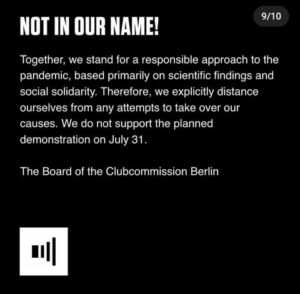This weekend Clubcommission is hosting a pilot indoor-event project with no-masks-required at full capacity. Parties from Friday, 6 August 22.00 – Sunday, 8 August 12.00 with up to 2,000 ticket-buyers will be able to travel between six clubs with no distancing requirements at venues.
The “PCR testing will take place at 3 mobile stations, which will be set up especially for the event and will be operated from Friday 6.8.2021 14.00 to 20.00 hrs.” For the testing there will be no distinction between vaccinated or unvaccinated people.
Tickets for the club night can be booked in advance via a ticket webshop for 15 euros plus a 10 euro “deposit”, which will be paid out after the event giving another test.
So we have 2000 people travelling between indoor venues across Berlin whilst partying in a socially, non-distanced environment without masks. Exposure to infections can happen at the event and outside of the event environment after the negative tested group has been selected.
A test after the event (on the 13. August – which is 5 days after the event) is not mandatory, so it’s not guaranteed that the team will detect infections or asymptomatic people.
From the FAQs:
“Any positive SARS-CoV-2 cases that occur in visitors after the event can be tracked and narrowed down to the time (and place) of infection (including the unlikely occurrence of infection during the event).”
Clubcomission even admits the “unlikely occurrence of infection during the event”. Unlikely is not scientific qualification to specify a safe environment which has the risk of superspreading a highly contagious virus.
How can this be a safe environment and how should infections be tracked down in time? What are people allowed to do after the event or between venues? The risk doesn’t just stop on Sunday afternoon when the party ends. The “safe environment of the cohort” cannot be guaranteed long enough to guarantee the safety of the participants and their surroundings.
Current infections in Berlin
Recent data even shows that Vaccinated People with Breakthrough Infections Can Spread The Delta Variant according to the United States Centers for Disease Control and Prevention (CDC).
“High viral loads suggest an increased risk of transmission and raised concern that, unlike with other variants, vaccinated people infected with Delta can transmit the virus,” Dr. Rochelle Walensky, the CDC’s director, said in a statement Friday.
How safe is this “pilot project”?
Below I will be referring to different studies of PCR false negative tests and all their conclusions.
False negative rate of COVID-19 PCR testing: a discordant testing analysis
“Studies to understand the FNR of routinely used assays are important to confirm adequate clinical performance. In this study, most FN results were due to low amounts of SARS-CoV-2 virus concentrations in patients with multiple specimens collected during different stages of infection. Post-test clinical evaluation of each patient is advised to ensure that rtRT-PCR results are not the only factor in excluding COVID-19.“
Estimating the false-negative test probability of SARS-CoV-2 by RT-PCR
“In conclusion, we demonstrate how the sensitivity of the RT-PCR assay for detecting SARS-CoV-2 infection depends on the time from symptom onset in symptomatic individuals, and show how nasopharyngeal swabs appear more sensitive than oropharyngeal swabs. In the absence of other testing procedures, this dependence on time since onset has implications for clinical decisions about treatment, and control / contact tracing decisions about who needs to be quarantined or can be released safely into the community. We also illustrate how, assuming that the false-positive test probability is negligible, the positive test count underestimates the number of infected individuals count in a cohort of tested individuals, which in turn has implications for estimates of case and infection fatality rates in the wider population.”
False negative: How long does it take for coronavirus to become detectable by PCR?
“Another study estimated that the probability of an infected person falsely testing negative on the day they contracted the virus was 100%, falling to 67% by day four of the infection. If they took a test on day five, the typical day people develop symptoms, the chance of a false negative result was 38%, dropping to 20% three days after the onset of symptoms (or day eight since exposure).”
“Care must be taken in interpreting RT-PCR tests for SARS-CoV-2 infection—particularly early in the course of infection—when using these results as a basis for removing precautions intended to prevent onward transmission. If clinical suspicion is high, infection should not be ruled out on the basis of RT-PCR alone, and the clinical and epidemiologic situation should be carefully considered.”
None of the studies above suggest a 100% potential of having a negative cohort based on the tests being taken. I acknowledge the involvement of the Charite Berlin, but this is a test where the logistics are being handled by Clubcomission and Think.Health Hygiene Solutions. Both organisations have a commercial interest in those events.
Even if we say we have a false negative chance of 0,5 % of a false negative we run into the risk of having 10 guests being positive with the high infectious delta variante to be leading to a super spreader event.
And last a study about: Estimating infectiousness throughout SARS-CoV-2 infection course
with one of the conclusions:
“We can safely assume that nonpharmaceutical interventions such as social distancing and mask wearing have been key in preventing many additional outbreaks. Such measures should be used in all social settings and across all age groups wherever the virus is present.”
The result and further steps
The highest risk is first and foremost that we can’t fully define a group of people as a negative cohort over the period of 56 hours. The conclusion according to the website of Clubcomission is: “In case of success – no infection during the event – it can be implied that similar events can be carried out in the future under comparable conditions.”
What does comparable conditions mean? Would every event replicating the pilot project require the same exact precautions and procedures? How should the test be reproducible with comparable experts on the PCR testing stations? The safety of false negatives as well as general test quality is highly dependable on the professionality of equipment and staff. How should this be a sustainable solution that will create a safe enough environment and “negative cohorts” that will be able to enjoy a night without hygiene regulations?
Social solidarity
We have witnessed rising numbers in positive COVID tests over many weeks nationwide, and specifically in Berlin. This pilot project hosted by Clubcommision is irresponsible toward visitors, staff members, and their extended environment whose lives and livelihoods are being put at risk. Let’s assume all of them can take their own decisions to put their bodies at risk. COVID-19 is not a pandemic of individual responsibility: Safety is based on collective responsibility. A super-spreader event will put the lives of people at risk who have not consented to the project and would not have participated.
The risk of mild infections and long covid are even possible for vaccinated people. The combination of not being able to 100% rule out the infections in the cohort and the lack of quarantining measurements after being potentially exposed to the virus without social distance is filled with too many uncertainties.
Besides this is not a inclusive approach towards the rest of the nightlife community. People with disabilities, immunocompromised people, essential workers or anybody who cannot afford to get sick with COVID-19 or Long COVID are unable to participate in an environment like this.
Furthermore it could create an atmosphere where people will forget the severity of the current situation and lose sight of the importance of social distancing.
It’s a classist and ableist approach to partying – if this becomes standardized, it could lead to a socially irresponsible and even more exclusive nightlife. This strategy places privilege and profit over the safety of people and their environments. None of the guests will be required to quarantine or follow safety precautions after the test event. The responsibility of hosting this pilot project doesn’t end when guests exit the venue’s doors
E-Mail Clubcomission to express your concern.
Comment Querdenken Appropriation
Since Clubcomission has blocked me on instagram I can only refer to this post with screenshots. As a public organisation working as the nightlife lobby with the government it is an issue to block critical community members without giving any feedback on point’s that are being addressed.


(image credit: https://www.instagram.com/p/CR4KPhBswgN/?utm_source=ig_web_copy_link)
With the above-mentioned pilot project Clubcommission is joining a reopening strategy that is irresponsible and has nothing to do with social solidarity. The reason Querdenker is using this is not a coincidence in my opinion. Clubcommission’s latest developments in politics to reopen without the necessary safety measures have shown that they share a political mutual ground.




